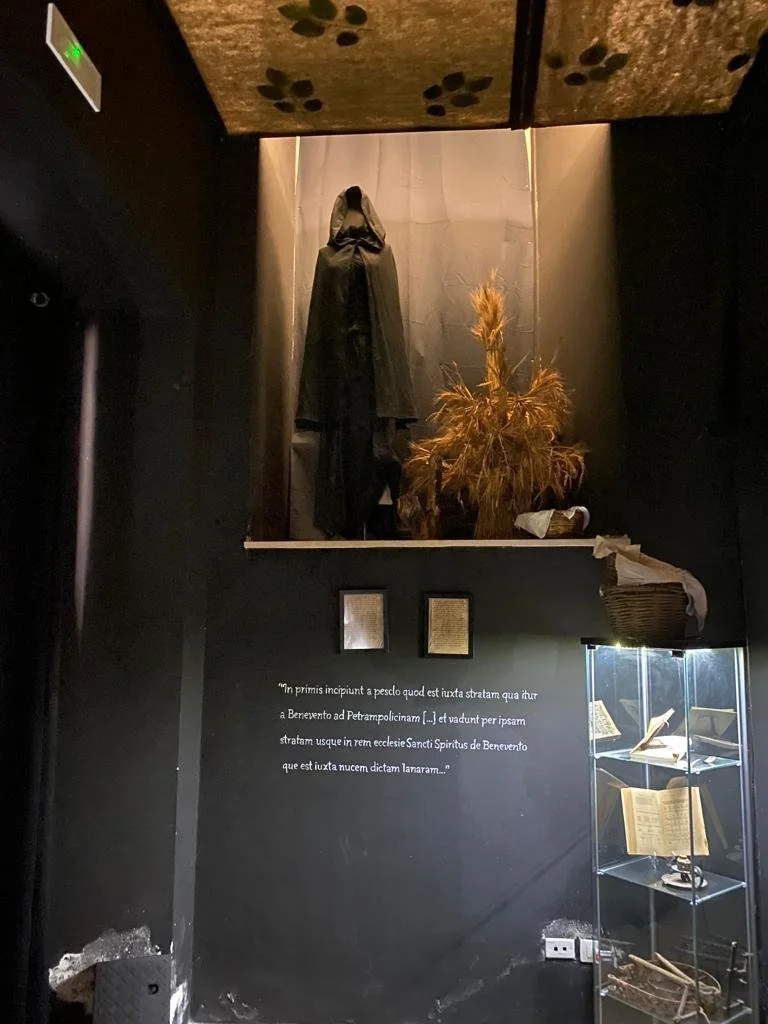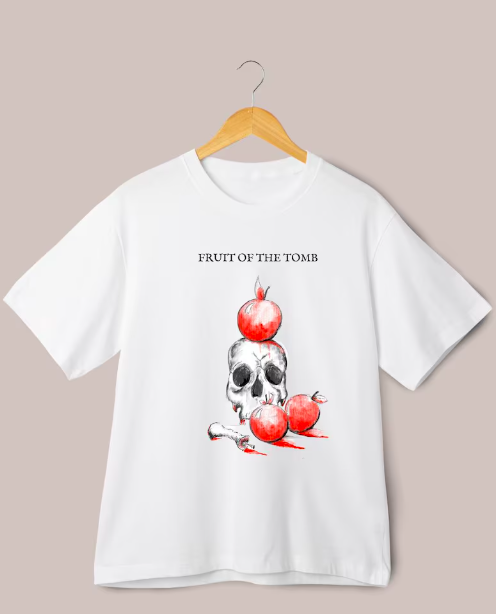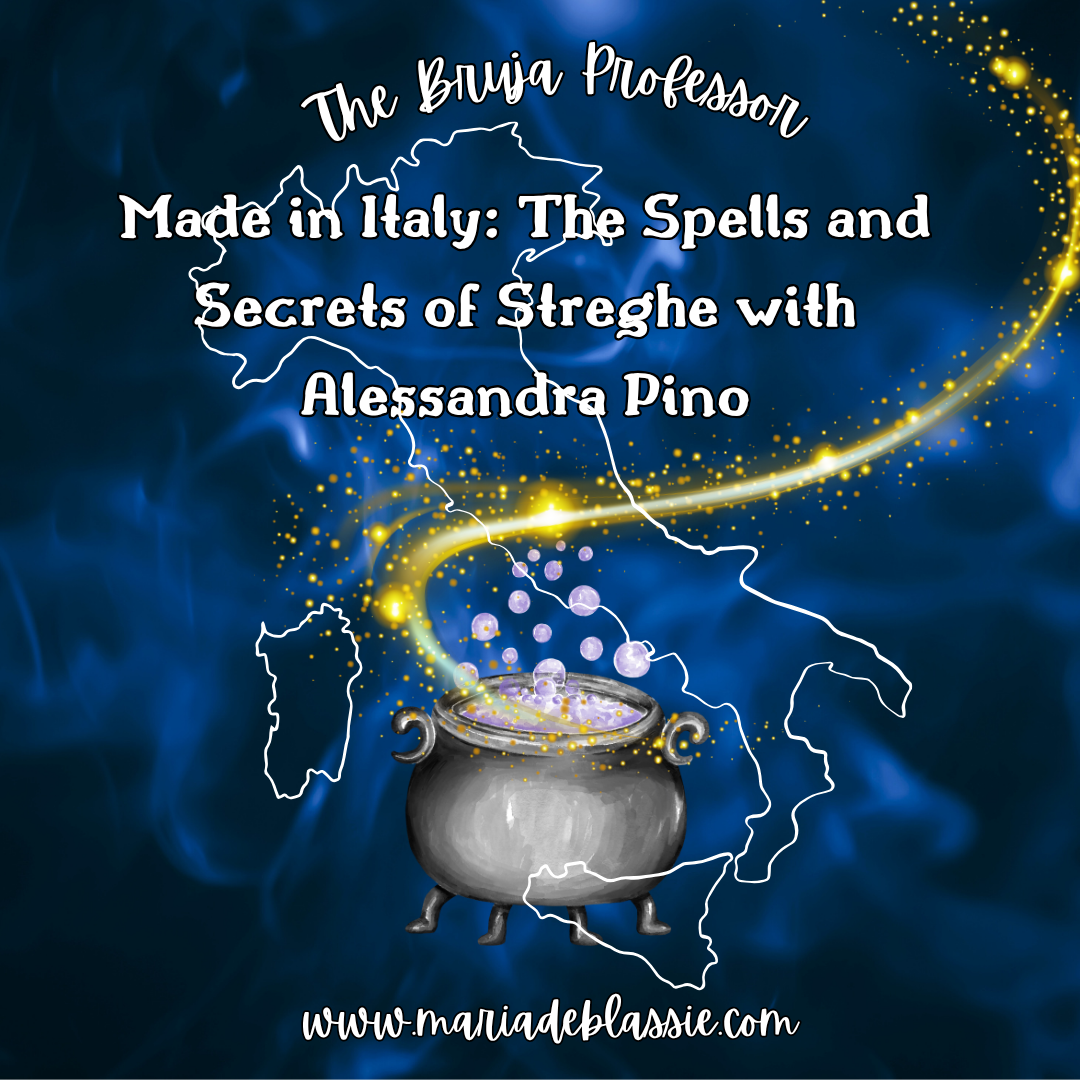This is a fantastic exploration of Italian witches in folklore and personal history by Alessandra Pino, who also wrote a fantastic article for The Bruja Professor on The Food of Witchcraft in Ira Levin’s Rosemary’s Baby.
Witches cloak at the Museo Streghe in Benevento, Italy.
Maria ‘a Longa
"Don’t you dare go down that road,"
The old woman warns, eyes aglow,
"For Maria ‘a Longa waits below,
Her fingers long as shadows grow."
She lived in a well, or so they say,
Silent, watching, waiting prey—
Rise she would, from darkened deep,
To pull the careless into sleep.
Once a woman, thin and tall,
Draped in black—a ghostly shawl.
Her husband woke to whispered words,
A spell, a flight, a world unheard.
With broomstick high, she soared, she flew,
Through midnight’s arch of starless blue.
Till tricked by lard, she leapt in vain—
A plunge, a scream, a death-stained rain.
And now she waits, her fingers cold,
To drag the living to the old—
The drowning place, the silent deep,
Where breath is lost, and souls must sleep.
I am half Italian, from a town called Nocera Inferiore, about thirty minutes by train from Naples and ten from Pompeii, where cobbled streets open into sunlit piazzas and quiet courtyards, but just as often narrow into winding alleys that squeeze the pavement into a mere sliver of shaded space.
"Don’t you dare go down there," my best friend’s grandmother warned, her finger trembling toward the darkened alley.
My friend would sigh, unimpressed, brushing off the old tales.
But me? I leaned in closer, always hungry for more.
"Why not, Signora?"
"Because Maria ‘a Longa is down there," she’d reply, lowering her voice. "A woman dressed in black, with long, long hands that reach up and snatch anyone who lingers too close to where the road gets darker."
The original story, she told us, was that Maria ‘a Longa had once lived in a well. The moment she saw someone near, she would rise from the water—faster than you could blink—grabbing them with her long, dark fingers and dragging them down into the depths, drowning them forever.
These stories were as much a part of my childhood as her cooking, and Maria ‘a Longa was one of the most terrifying. According to her, Maria ‘a Longa had once been the wife of Giovanni, a farmer from the Benevento countryside. She was tall and thin, always dressed in black, and rarely spoke. One night, Giovanni was jolted awake by a strange noise. What he saw made his blood run cold—his wife, standing by the window, was rubbing a mysterious ointment onto her body. Without hesitation, she climbed onto the windowsill, mounted a broomstick, and leapt into the night, soaring into the sky.
The next morning, deeply disturbed, Giovanni rushed to his mother in the village.
"Mamma, what have I married? I saw her with my own eyes—flying on a broomstick!"
His mother gasped. "Giovà, that’s no Befana you’ve got at home—that’s a strega! You need to be very careful!"
Following his mother’s advice, Giovanni replaced his wife’s enchanted ointment with lard, which looked exactly the same. Nothing happened for days, but when Saturday night came, she followed her usual ritual—rubbing the ointment on her body, mounting the broom, and murmuring strange words before launching herself from the window.
This time, she didn’t fly.
A scream rang out, followed by a heavy thud and a loud splash. Maria ‘a Longa had plummeted straight down, hitting her head on the edge of the well beneath the window and falling in. She drowned, and from that night on, her restless spirit haunted every well, waiting to pull down the unwary—especially children.
Maria ‘a Longa wasn’t the only witch La Signora warned me about. Benevento had others—the Zucculara and the Janara.
The Zucculara was a limping witch who haunted the Triggio, the old Roman theatre district. She chased after solitary passersby, her wooden clogs clattering against the cobblestones. No one had ever seen her face—no one had dared to turn around.
The Janara, though, was the most feared. She was said to be a woman born at midnight on Christmas Eve, but due to a mistake by the priest at her baptism, she never properly received the sacrament of confirmation, and so she became a Janara. Some say her name comes from ‘Dianara,’ linked to the priestesses of Diana, the ancient goddess of the moon, forests, and childbirth. Others claim it comes from ‘ianua,’ meaning door, because the Janara slipped under doors in the form of a whispering wind.
La Signora told me you could protect your home from a Janara by placing a broom upside down behind the door or scattering salt. Janare suffered from an uncontrollable urge to count things, and before entering, they’d be forced to count every bristle of the broom or every grain of salt—taking them all night, until dawn drove them away.
If you ever suspected a Janara’s presence, you had to say, "Janara, today is Saturday," reminding her it was time to fly to the legendary walnut tree of Benevento, where witches gathered every Sabbath. Another trick was to grip her hair. If she asked, "What do you have in your hand?" you had to answer, "Iron and steel." If you said "hair," she’d slip away, cackling, "I’ll slither away like an eel!"
Janare also had a nasty habit of tormenting sleepers, sitting on their chests and causing nightmares—a shadowy presence pressing down, leaving victims gasping for breath. They stole horses from their stables, riding them to exhaustion and weaving mischievous braids into their manes. And if a baby woke up twisted in their crib, people would whisper that a Janara had passed them through the keyhole in the night.
La Signora’s stories were meant to scare me into obedience—don’t go down dark alleyways, stay away from wells, don’t open doors at night, don’t mess with things you don’t understand. But they also made the town feel alive with shadows and whispers, with the past reaching into the present. And, honestly, even now, I’d think twice before walking down a dark alleyway.
Unlike my own grandmother, whose Catholicism was deeply devout but devoid of superstition, my friend’s grandmother fully embraced these beliefs. She would recount stories of malocchio with unwavering conviction, and she possessed a natural ability to interpret dreams according to la Smorfia. Her house was adorned with protective charms—horseshoes above doors, garlic wreaths in the kitchen, and, of course, a corno tucked discreetly in her purse. Through her, I came to understand how deeply these superstitions were woven into everyday life, serving as both a source of caution and a means of comfort.
The Janara’s Curse
She slips beneath the door at night,
A whisper, thin, a stolen sight.
She presses down upon your chest,
A weight of air, a dream’s unrest.
She braids the mane of weary steed,
She makes the sleeper toss and plead.
She rides the wind, she laughs, she sings,
And turns the night to haunted things.
But lay a broomstick by the door,
Or scatter salt upon the floor.
For she must count—each bristle, grain,
Till morning breaks the curse again.
And if you catch her by the hair,
Hold fast, speak true, do not despair.
Say "Iron and steel!"—her fate is sealed,
Say "Hair," and she is free to yield.
Neapolitan Superstitions: An Origin Story
The rich and evocative superstitions of Naples have deep roots in the hardships and misfortunes that afflicted the city, particularly in the 19th century. But what exactly is superstition? According to the Roman orator Cicero, the superstitious were those who, through prayers, offerings, and sacrifices, sought divine intervention for salvation. More specifically, superstition can be understood as an irrational belief that objects or behaviours can influence future events.
One of the most enduring and feared superstitions in Naples is the malocchio (evil eye), the belief that a person can cause harm—whether intentionally or not—through a malevolent gaze that transmits negative energy. It is thought that this tradition took hold in Naples around the 18th century, giving rise to protective amulets such as the horseshoe, the gobbetto (hunchback charm), the garlic wreath, and most notably, the corno (horn). The corno remains the most widespread protective talisman in Neapolitan homes. According to ancient tradition, for it to be effective, it must be handmade, hard, hollow, curved, and pointed.
Superstition also intertwines with la Smorfia, the mystical tradition of interpreting dreams and translating them into numbers for the lottery. Every extraordinary event or dream is assigned a numerical value, which believers use to seek fortune.
The Role of King Ferdinand IV and the Power of the Jettatura
The concept of jettatura—the ability to unwittingly bring misfortune—became particularly entrenched in Naples in the late 18th century, especially at the court of King Ferdinand IV. It is said that the renowned archaeologist Andrea De Jorio, though respected for his scholarship, was also feared as a powerful jettatore (bringer of bad luck). When De Jorio visited the king, rumours of his alleged powers caused much unease. The following day, King Ferdinand IV died—most likely due to natural causes related to old age. However, the event cemented the Neapolitan people’s belief in jella (bad luck), making jettatura a force to be reckoned with. The term jettatura comes from the Latin jacere sortes (“to cast fates” or “to enchant”) and refers to the involuntary projection of harmful energy through an envious gaze.
A Closer Look at the Evil Eye
The malocchio is believed to manifest through symptoms such as severe headaches, nausea, depression, and an overall sense of unease. According to popular belief, certain women—often elderly—possess the ability to diagnose and cure the malocchio through a ritual involving olive oil and water. This knowledge is traditionally passed down through generations, but once the healer imparts the skill, she loses the ability to perform the ritual herself. Because of this, the transmission usually occurs when the healer senses that her life is nearing its end.
The Ritual of Oil Divination
To perform the ritual, the afflicted person must sit while the healer pours water into a shallow dish. The healer then makes the sign of the cross three times on the person’s forehead while murmuring secret prayers, followed by a well-known incantation:
“Aglie, fravaglie e fattura ca nun quaglie, ‘uocchie, maluocchie e frutticiell rind’ all’uocchie, corna, bicorna e la sfortuna nun ritorna, sciò sciò, ciucciuè.”
The healer makes the sign of the cross again, drops olive oil into the water, and observes the oil’s reaction. If the drops spread out, it confirms the presence of the malocchio. If they dissipate entirely, the curse is old and harder to break. The healer then “cuts” the eyes formed in the water with scissors, disposing of the liquid in a place where no one will step on it. The ritual is repeated over several days until the oil drops remain small, signalling that the curse has been lifted.
Benevento: Italy’s Witchcraft Capital
Benevento, located in southern Italy, has been associated with witchcraft since the Middle Ages. According to legend, this town was a gathering place for witches who performed nocturnal rituals beneath an ancient walnut tree. These witches, known as janare, were believed to possess supernatural abilities, such as shape-shifting, casting spells, and controlling the elements. Unlike the demonic witches of Salem, the janare were regarded with ambivalence—feared for their powers, yet also sought after for their healing abilities and knowledge of herbal medicine.
The Church viewed Benevento’s gatherings as heretical, and it worked to suppress these pagan traditions. The infamous Coven of Benevento was a key target during the Italian witch trials, which only solidified the region’s reputation as a hub of supernatural activity. This dark history permeates Suspiria, where a powerful matriarchal coven operates under the guise of an elite institution—much like the janare who existed in the shadows of Italian society.
Benevento, Italy.
Suspiria and the Legacy of Italian Witchcraft
Dario Argento’s Suspiria (1977) is a hallmark of horror, blending vivid colour palettes, unsettling sound design, and nightmarish storytelling. While its stylized, surreal nature captures the imagination, its roots run deep in the folklore of Italian witchcraft. The film’s eerie atmosphere and its portrayal of a coven operating within a prestigious dance academy draw direct inspiration from Italy’s complex history with witches—most notably le streghe di Benevento, the legendary witches of Benevento.
The Three Mothers and Occult Influence
The central mythos of Suspiria—the Three Mothers—originates from Suspiria de Profundis, a 19th-century collection of essays by Thomas de Quincey. Argento and co-writer Daria Nicolodi expanded this concept into a triad of ancient, malevolent witches ruling different parts of the world. The film introduces Mater Suspiriorum, the Mother of Sighs, who oversees the Freiburg-based dance academy. While de Quincey’s idea was literary, its adaptation into Italian horror resonates with the traditions of Italian witchcraft.
In Benevento’s folklore, witches were often led by a powerful and invisible figure—much like Helena Markos in Suspiria. This hidden, ruling witch mirrors the stories of matriarchal figures who controlled arcane knowledge from the shadows. Additionally, the film’s use of incantations and esoteric symbols recalls the practice of stregheria, Italian folk magic that involves spellcasting, charms, and invoking supernatural forces. One of the most striking elements of Suspiria is its use of sensory overload to convey the supernatural. The exaggerated colours, the almost hallucinatory Goblin score, and the disorienting cinematography immerse the viewer in an otherworldly realm. This is in line with historical descriptions of Italian witchcraft, where rituals often involved heightened sensory experiences—strange music, flickering candlelight, and intoxicating herbal concoctions. Just as initiates into a coven might undergo a transformative journey, Suzy Bannion, the protagonist, must navigate a labyrinth of illusion, terror, and ultimate revelation.
Are Blenders the New Cauldrons? What’s in That Smoothie?!
Food plays a pivotal role in films where witches manipulate their victims through the act of eating. In Rosemary’s Baby (1967), for example, the kitchen is a place of domesticity but also subtly represents danger. When Rosemary first sees her new apartment, she notices:
“The first room on the right was the kitchen, and at the sight of it [she] couldn’t keep from giggling, for it was as large if not larger than the whole apartment in which they were then living. It had a six-burner gas stove with two ovens, a mammoth refrigerator, a monumental sink…”
Rosemary’s vulnerability, stemming from societal expectations and personal insecurities, renders her susceptible to manipulation through seemingly innocuous offerings, such as smoothies. Similarly, in The Witches (1983) by Roald Dahl, witches use chocolate to deceive children, luring them to their doom. In The VVitch (2015), an apple becomes the conduit for supernatural forces, evoking the biblical tale of temptation and corruption. Likewise, in Suspiria (1977), the coven of witches uses food to control and seduce, ensuring their victims are ensnared before they even realize the danger.
Fear Feasts podcast considers the eerie connections between food and horror, examining how meals become tools of manipulation, symbols of power, and sometimes, even harbingers of doom. Each episode, we dissect the most chilling food moments in horror films, from cursed feasts to deadly delicacies. The season dedicated to witchcraft is available and explores a haunting array of witch-themed horror, including The Witches of Eastwick (1987) by John Updike, Suspiria (1977) directed by Dario Argento, The Witches (1990) based on the novel by Roald Dahl, The VVitch (2015) directed by Robert Eggers, Hex (2018) by Thomas Olde Heuvelt, Don’t Knock Twice (2016) directed by Caradog W. James, The Craft (1996) directed by Andrew Fleming, The Craft: Legacy (2020) directed by Zoe Lister-Jones, Lolly Willowes (1926) by Sylvia Townsend Warner, Practical Magic (1998) directed by Griffin Dunne based on the novel by Alice Hoffman, and The Witching Hour (1990) by Anne Rice. Tune in and uncover the chilling role food plays in these dark tales of witches and magic!
T-shirt with a skull and pomegranate illustration on it that says, “fruit of the tomb.”
I have recently launched a line of Gothic Food-inspired t-shirts available here. As a reader of The Bruja Professor, you can use a special discount code here.
Guest Contributor Bio
Dr. Alessandra Pino holds a PhD in Food, Cultural Memory, and the Gothic from the University of Westminster, following a decade of experience working alongside a Michelin-starred chef. Her research and publications cover topics such as food, cultural memory, the supernatural, and the Gothic. She regularly contributes to Haunted Magazine and Rue Morgue. Alessandra is the co-author of A Gothic Cookbook (2024) and has a forthcoming chapter on Dark Food in The Palgrave Handbook of Literary Memory Studies (2025). She is the writer, producer, and co-host of A is for Apple podcast, which investigates the history of food, and Fear Feasts, a podcast that analyses the horror genre through the lens of food. She is a member of the Guild of Food Writers.
Alessandra's website: www.alessandrapino.com
Map of Italy with a bubbling cauldron and magical sparkles, with the text, “The Bruja Professor: Made in Italy: The Spells and Secrets of Streghe with Alessandra Pino.”
The Bruja Professor, a witchy take on literature, the occult & pop culture, is the scholarly sister to Enchantment Learning & Living, an inspirational blog celebrating life’s simple pleasures, everyday mysticism, and delectable recipes that are guaranteed to stir the kitchen witch in you.
If you enjoyed what you just read and believe that stories are magic & true magic is in the everyday…or your next good read, subscribe to my newsletter below for regular doses of enchantment.
Want even more inspiration? Follow me on Instagram and Facebook. Here’s to a magical life!



